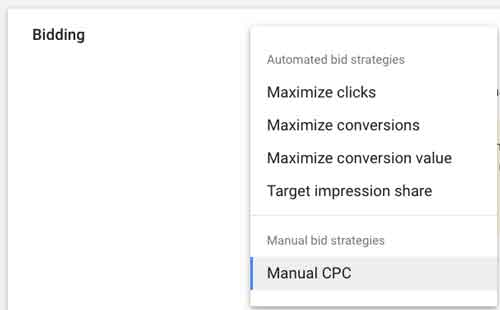Almost all Google Ads advertisers will ask themselves the same question at one point: “should I use automated bidding and put my Google Ads on autopilot?”. The answer will depend on many factors. Automated bidding in Google Ads has improved a lot over the years, but you need to choose your strategy very carefully. In this article, you are going to learn how they work, their pros & cons, and hopefully choose the best one for you.
You’ll also learn:
- The difference between manual bidding, automated bidding, and Smart Bidding;
- Cautions to take for each bidding strategy.
Yes, different types of automated bidding strategies can help you increase your clicks and conversions – but only when they are used wisely. Otherwise it can be a complete disaster.
What is automated bidding?
When you create a Google Ads campaign, you have to tell Google how much you’re willing to pay for a click on your ad. This is called your bid, and there are basically two ways to set your bids:
- manual or
- automated.
With manual bidding, you set the maximum amount you want to pay per click manually. You can make adjustments to that bid over time, based on your ad’s performance.
With automated bidding, Google uses automated rules to set the bids for you – based on the ad’s likelihood of getting a click or generating a conversion. There’s no need to change bids for specific ad groups or keywords manually. Automated bidding may even use additional data that isn’t available in reporting metrics.
There are nine options of automated bidding in Google Ads:
- Enhanced CPC (ECPC)
- Maximize Clicks
- Maximize Conversions
- Maximize Conversion Value
- Target Impression Share
- Target Cost Per Action ( tCPA)
- Target Return on Ad Spend (tROAS)
- Viewable CPM (vCPM)
- Cost Per View (CPV)
Is Smart Bidding the same as automated bidding?
Smart Bidding and automated bidding are often confused, but they are not the same thing. Smart Bidding refers only to Google’s automated bidding strategies that use auction-time bidding, which means it will optimize for conversion or conversion value in each and every auction. Smart Bidding strategies include:
- Enhanced CPC (it partially automates your manual bids by adjusting your max CPC)
- Maximize Conversions
- Maximize Conversion Value
- Target CPA
- Target ROAS
All Smart Bidding strategies are automated, but not all automated bidding strategies are Smart Bidding strategies.
How to set your bid strategy
When you’re setting up a new campaign, Google will automatically choose an automated bidding strategy for you based on your goals. But you do not have to use this default strategy. You can choose any other, or even choose to bid manually.
To do so, click the campaign whose bids you want to change and select “Settings” from the left menu.
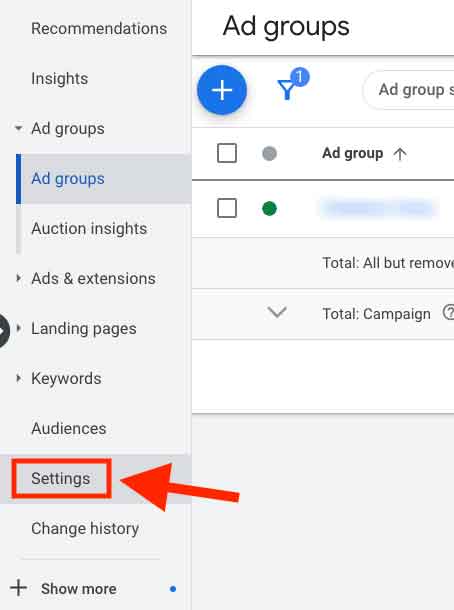
Next, click the “Bidding” section.

Simply select the blue text at the bottom where it says “Change bid strategy”.
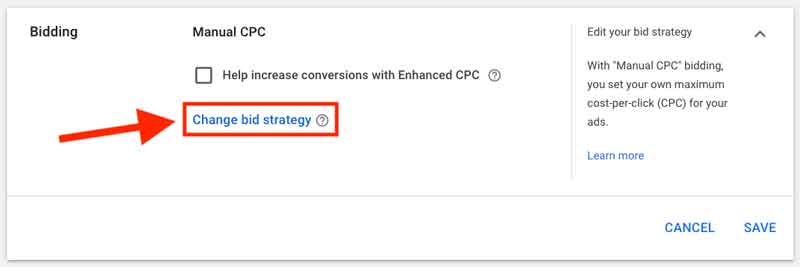
Then you’ll see all available bid strategies:
- Maximize clicks;
- Maximize conversions;
- Maximize conversion value;
- Target impression share;
- Manual CPC.
Automated bidding options in Google Ads explained
1. Manual CPC (non-automated)
Note: although Manual CPC is not an automated bidding strategy, it is important to understand it so you can learn Enhanced CPC (which is an automated strategy) next.
Manual bidding is the easiest bid strategy to grasp in Google Ads. You will set your bids manually at the keyword or ad group level, and the bids will remain the same until you change them manually again.

Caution with Manual CPC
Choosing manual bidding has one main drawback: you need to invest time.
Manual bidding requires much more time because you have to look at performance, decide if the keyword bid needs to be changed, decide what that change will be, calculate the impact it will have on the campaign’s budget, and then finally make the change.
But if you do have the time to manage your account, don’t hesitate: choose Manual CPC and monitor keyword by keyword, bid by bid manually.
2. Enhanced CPC (automated, under Manual CPC, Smart Bidding strategy)
Enhanced CPC is similar to manual bidding, but it allows the Google Ads algorithm to make changes to a keyword bid that was manually set.
ECPC is actually different from other Smart Bidding strategies. They both work to get you more conversions and conversion value, but the main difference is that ECPC partially automates your manual bids by adjusting your max CPC, and you won’t be able to set an explicit target.
The other Smart Bidding strategies completely automate your bids based on the CPA, ROAS, or desired budget target that you set, and don’t require you to set bids manually.
Smart Bidding gives you the very best chance to improve your results. However, ECPC provides a level of manual control that some people prefer.
Enhanced CPC will adjust bids for keywords based on the likelihood of that click leading to a conversion.
You can get Google to adjust bids according to either one of these two goals:
- optimize for conversions
- optimize for conversion value.
It could be a good first step into automation if your account has been performing really well. You can enable Enhanced CPC by checking the box below “Manual CPC” that says “Help increase conversions with Enhanced CPC”, and leave the option “Optimize for conversions” selected.
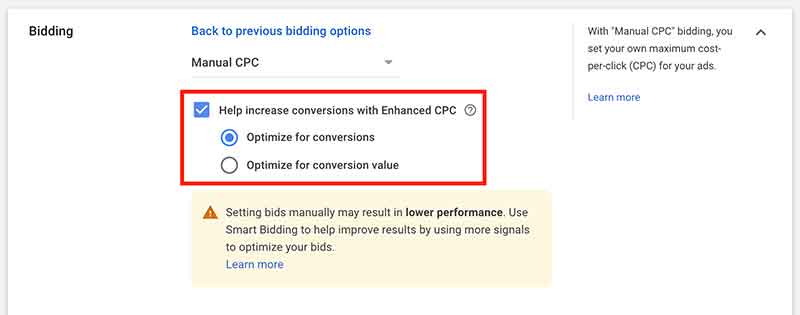
There is a caution box that says “Setting bids manually may result in lower performance. Use Smart Bidding to help improve results by using more signals to optimize your bids.” I have explained those signals at the end of this post.
Whether Google’s warning (in the screenshot above) will be true or false really depends on your campaign settings, your keyword list, your business sector, and other factors. Don’t get scared. If you have some time to manage your keyword bids, go ahead and use Enhanced CPC as a test – and monitor your campaign very closely. If it works, great. If it doesn’t, switch back to Manual CPC and take good care of your bids one by one manually.
The most common results of successful use of Enhanced CPC are increased click-through rate (CTR) and conversion rate.
Cautions with Enhanced CPC
You need to keep an eye on your metrics. I recommend doing that twice a day.
Monitor CPC and CPA
Since Enhanced CPC will adjust keyword bids with no limit in place, there is a great chance bids and CPCs can be much higher than what is profitable for your business.
The whole purpose of this type of bid is to increase the likelihood of conversions, but maybe “not exactly” at the target cost per conversion (CPA) you have in mind.
So keep an eye on CTR and CVR (Conversion Rate) to see if your bidding strategy is working as expected (both should go up), but also track CPC and CPA to ensure your campaign is still profitable.
3. Maximize Conversions (Smart Bidding strategy)
While Enhanced CPC is a semi-automated bidding strategy, Maximize Conversions is fully automated. This means there are no individual keyword bids set by us, advertisers. Google will simply choose a CPC bid based on the goal of the bidding strategy.
The Maximize Conversions bid strategy is designed to get as many conversions as possible without exceeding your daily budget. It also gives you the option to add a target CPA to help guide its bidding.
Maximize Conversions: cautions
Check your daily budget amount
Before switching to Maximize Conversions, check your average daily budget amount. Maximize Conversions will always try to spend all your average daily budget. Therefore, if you’re spending much less than your budget now, Maximize Conversions could increase your spending a lot.
Each campaign needs to have its own daily budget
Each campaign using Maximize Conversions really needs to have its own daily budget properly set – as opposed to belonging to a shared budget – as this bid strategy will always try to spend the whole daily budget. If you include it in a shared budget, Maximize Conversions will spend the daily budget of the entire group – not just its own slot. So, be careful.
Make sure conversion tracking is working 100% right
You should never run this strategy without having conversion tracking in place. Google’s objective here is to maximize the number of conversions that are being tracked when you start using this bid strategy. So if there is no tracking enabled or if conversions are being tracked mistakenly, the algorithm will either:
- not learn anything at all (because there are no conversions) or
- learn the wrong lesson (e.g. because the wrong conversion is being tracked or because there is a problem with the conversion setup).
Keep track of CPC
Don’t forget that Google’s algorithm is going to bid as high as it needs to get you the most conversions. Your total cost or average CPC can go up as Google bids more aggressively to meet your conversion goals.
However, while your spend or average CPC may be higher, you could have more conversions coming in – which might result in an overall lower CPA and higher ROI. Also, with the option of adding a target CPA, these risks can be minimized.
In short, if your goal is to get more leads for less, Maximize Conversions might work for you.
4. Maximize Clicks
This bidding strategy is similar to Maximize Conversions but it focuses on clicks. With Maximize Clicks, Google will work to give you as many clicks as possible while spending your daily budget.
This strategy can be great if you’re trying to get more traffic to your site for branding and remarketing list building, or if you already have very good conversion performance and want to get more conversions.
You can set a max CPC limit to help keep CPCs down.
Cautions with Maximize Clicks
You should always set a max CPC bid limit and monitor your average CPC very closely.
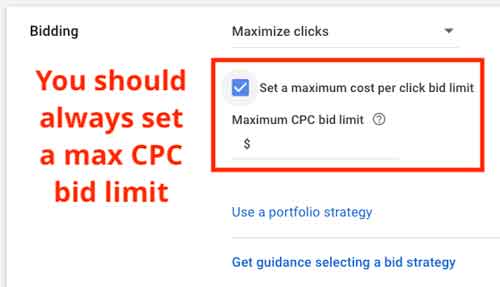
Google will work hard to get as many clicks as possible for your campaign, but as with Maximize Conversions, it will also do its best to spend all your daily budget every day – even if clicks are much more expensive than usual.
5. Maximize Conversion Value (Smart Bidding strategy)
This is a more advanced version of the Maximize Conversions strategy. While both are fundamentally the same, Maximize Conversion Value aims to get conversions that will give you the highest return. It doesn’t really look at how many conversions it is bringing in, but the value within each conversion. It is a bid strategy that prefers quality over quantity.
Just like Maximize Conversions allows you to set a Target CPA, Maximize Conversion Value lets you set a Target ROAS to help guide its bidding.
Cautions with Max Conversion Value
Conversion tracking
Setting up conversion tracking correctly is essential here – as it is with Maximize Conversions.
Assign values correctly
Be sure each conversion action is assigned a propper value, otherwise the algorithm will be confused. After all, a conversion worth $200 to your business deserves a much higher bid than one worth only $30.
6. Target CPA (Smart Bidding strategy, under Maximize Conversions)
Target CPA stands for Target Cost Per Action (or conversion), and it is found under Maximize Conversions.

With this bidding strategy, you set a target cost per action (conversion) and Google adjusts bids to get as many conversions as possible at that CPA.
Target CPA is available as either a standard strategy in a single campaign or as a portfolio bid strategy across multiple campaigns.
Cautions for Target CPA
Conversion tracking is required
Like Maximize Conversions and Maximize Conversion Value, Target CPA requires conversion tracking enabled – and working – in your Google Ads account. Without conversions, this bidding strategy simply won’t work because it will never know if it is getting conversions or not.
Minimum conversion data required
To improve conversion performance, Google needs to have a minimum amount of conversions to be able to make the best decisions. If your campaign doesn’t reach that volume, the algorithm won’t be able to make smart decisions.
If your campaign has historical conversion data, the system will recommend a target CPA. This recommendation is based on your CPA performance over the last few weeks.
Set a realistic target
It is crucial to set realistic goals. If your campaign has had an average CPA of $50 over the last three months, you really don’t want to set a target CPA of $15, as it will limit Google’s learning (mostly because it will limit the number of auctions in which you can take part).
This means you should see the first two or three weeks as a learning phase. Set your target CPA a little bit higher than your average CPA has been recently, or use Google’s suggested target CPA to let the system learn, then gradually bring it down over time to your desired target CPA.
7. Target ROAS (Smart Bidding strategy, under Maximize Conversion Value)
Target ROAS is pretty much the same as Target CPA, but it uses Return On Ad Spend (ROAS) instead. And just as Target CPA can be found under Maximize Conversions, Target ROAS can be found under Maximize Conversion Value.
Target ROAS can be used either as a standard strategy for a single campaign or as a portfolio strategy across multiple campaigns.
With Target ROAS, Google Ads will predict future conversion and conversion value performance based on your historical data, and then adjust bids in real-time to try to achieve the target ROAS goal you’ve set at the ad group, campaign, or portfolio level.
As with Target CPA, conversions may have higher or lower ROAS, but Google will work to balance those out over time to achieve your Target ROAS.
With this bidding strategy, advertisers can set bid limits (minimum and maximum) at the campaign or portfolio level to make sure Google won’t go too far, but the system will warn you against this, as it can limit machine decision-making.
Target ROAS: before you start
- Before you can apply a Target ROAS bid strategy to your campaigns, you’ll have to set values for the conversions you’re tracking. See all the details here.
- You can also use conversion value rules to express the value of conversions more precisely (as they relate to your business), and optimize towards conversions from the user profiles that are more valuable to you. Read more about conversion values here.
- To use Target ROAS, most campaign types need at least 15 conversions in the last 30 days.
- Display campaigns will need at least 15 conversions in the last 30 days.
- App campaigns will need at least 10 conversions every day, or 300 conversions in 30 days.
- Discovery campaigns will need at least 75 conversions in the last 30 days, and 10 of these conversions must have occurred in the last 7 days.
Target ROAS – Cautions
All the same cautions for Target CPA will apply to Target ROAS.
Accurate conversion data
Make sure you have accurate conversion tracking in place – including conversion values – and that you have enough conversion performance in the last few weeks to boost this strategy.
Realistic Target ROAS
Be careful not to set your target ROAS at a restrictively high level right at the start. Begin with a slightly lower goal than what your performance has been recently, then slowly raise your target to achieve a profitable ROAS.
8. Target Impression Share
With Target Impression Share, you will set a goal impression share percentage in the exact same way you would set a target CPA for that bidding strategy. There are three placement options for bidding:
- Absolute Top of Page
- Top of Page
- Anywhere on the Page
Google will automatically set bids with the goal of showing your ad on the placement you choose.
Target impression share is available only on the Search Network, either as a standard strategy in a single campaign or as a portfolio bid strategy across multiple campaigns.
We can also set a max CPC bid to avoid overspend, but keep in mind that setting it too low might affect your performance.
Target Impression Share can be very handy for campaigns with brand terms. For example, suppose you want your ad to be shown 100% of the time when users search for your brand name. In that case, you can simply set the Target Impression Share to 100% and Google will then try to show your ad on 100% of auctions in that campaign.
This bid strategy can also be very useful for brand awareness. Let’s say you run ads for a local clothes store but you’re competing with much bigger clothes stores. You could use Target Impression Share to make sure your ad is shown when customers are searching for relevant keywords nearby.
Cautions for Target Impression Share
Like any other automated bidding strategy, Target Impression Share can increase your bids beyond profitability. This strategy is mainly for awareness and reach – though it can also be used for performance.
Keep an eye on CPC
You should always set a max CPC bid to avoid paying too much for clicks. Although Google will give you a warning against it, don’t worry about setting this bid a bit too low to start. If you don’t see the traffic volume you want, increase the max CPC gradually.

Very few auctions – in very few business sectors – will actually see 100% coverage. So don’t be frustrated if you set a target impression share to 100% but only show up on 90% or 95% of the auctions.
9. Viewable CPM
Viewable CPM actually stands for “cost-per-thousand impressions”. An ad is deemed as “viewable” when 50% of it shows on screen for 1 second or longer for display ads, or plays for 2 seconds or longer for video ads.
This is a display-only bid strategy. You can use viewable CPM when you choose CPM bidding for your “Display Network only” campaign.
Viewable CPM bidding is great if you’re working on brand awareness and want to get your brand name in front of a larger audience.
Benefits of Viewable CPM:
- You will pay only for impressions counted as viewable.
- Your bids are calculated so as to favor ad slots that are more likely to become viewable.
Cautions for Viewable CPM
Frequency
With this bidding strategy, Google will do its best to maximize the number of viewable impressions your ad gets. If you use this strategy with a finite audience, your chances of getting a high-frequency count for each user (i.e. the same user seeing your ad too many times) increase a lot.
We have all seen those ads that seem to stalk us as we surf the web. So make sure you are not going to do the same – to visually exhaust your audience – with your ad.
Placements
As in every display campaign, it’s crucial to keep an eye on your placements report to make sure your ads are not being shown on unwanted sites.
Pro tips
-
- Your ad group default bid can be seen in the statistics table next to a “(viewable)” label. This will help you identify your viewable CPM bids more easily.
- Here’s how to keep track of your viewable impressions:
- From the navigation menu on the left, click “Display campaigns” or “Video campaigns”, depending on what you need to see.
- From the page menu on the left, click “Campaigns”, “Ad groups”, or “Ads & extensions”.
- Click the “Columns” drop-down icon right above the statistics table, then click “Modify columns”
- Click the “Viewability” dropdown menu.
- Select the columns you want to see by checking the box to the left of each one.
10. Cost Per View (CPV)
Cost-per-view (CPV) bidding is the default strategy to pay for TrueView video ads in Google Ads. With CPV bidding, you’ll pay for video views or interactions (e.g. clicks on call-to-action overlays, cards, etc.). A “view” is when someone watches 30 seconds of your video ad (or the whole duration if the ad is shorter than 30 seconds) or interacts with the ad, whichever comes first.
Bidding on individual views is only available for video ads. With Cost Per View, you set a bid limit at the campaign level, and that limit will be the maximum you’re willing to pay for every individual view or interaction with your video, whichever comes first.
You will only be charged for a view if someone watches your video for more than 30 seconds (or the whole video if it is shorter than 30 seconds).
With CPV and video ads reporting, you will be able to see how engaged users are with your content, where they choose to watch your videos, and when they stop watching your content.
Analyzing the performance of your video ads is crucial to the success of your campaign. By using the reporting tool in Google Ads, you will find metrics such as impressions, views, engagement, clicks, and also the type of audience your video ads are reaching. You should monitor this data very closely.
Caution with CPV
If your video campaign’s targeting is wide, be careful! If you’re getting thousands of views at a much cheaper cost, it probably won’t make sense for you to use CPV. Because you’re bidding on individual views, you will only want to spend money when it really counts. Therefore, if you have wider targeting this will be a lot more difficult to control.
Some of the automated bidding signals Google uses in all Smart Bidding strategies
User’s physical location
Google Ads can change bids based on the exact location (down to the city) of the user, even when the advertiser’s location targeting isn’t very specific.
User’s device
Google Ads can change bids for Target CPA or Target ROAS strategies (both have been explained in this article) based on whether someone is using a mobile device, a desktop (or laptop) computer, or a tablet.
Day of the week and time of day
Google Ads can change bids based on the user’s local time and day of the week (in their time zone).
Location intent
Google Ads can change bids based on someone’s location intent in addition to their physical location. For example, suppose you are a travel agency. Your bids can be optimized if someone is researching a destination you offer (e.g. “lisbon vacations july”) even if this user is not physically located there.
Ad content, format, and size
Google Ads can change bids based on the version of the ad that will be shown.
Remarketing list
Search, Display, and Hotel bids can be changed based on the remarketing list the user belongs to. Search and Display may also take into account the date when a user was added to that list. Search also considers each list a user is on for a given campaign or ad group.
User’s interface language
Google Ads can change bids based on the user’s language settings.
User’s browser and operating system
Google Ads can change bids based on the user’s browser and operating system.
If you have chosen your automated bidding strategy, remember: set it, but don’t forget it!
Automated bid strategies in Google Ads are a great way to save time while teaching the algorithm to optimize your campaign or ad group.
Automated bidding strategies require less time than manual bidding, that may be true. But it is not a “set it and forget it” deal.
My advice: use your calendar and set reminders to check them out from time to time. Don’t lose track of your metrics – otherwise, you might lose a lot – and I mean a lot – of money.

